Reseach Highlights
Press-release on the Tubeclean project (11.2023)
Latest news of the collaboration between the Tiefbohrbär GmbH (TBB) and PSI regarding cleaned waveguide tubes with both the precision and low surface roughness required by ITER (France). Since a significant part of such waveguide tubes will be near to the ITER torus, highest contamination standards (VQC 1A) must be fulfilled, and in UHV high magnetic fields environment, metallic particles or residues of oils, cooling emulsions or other chemicals coming from production process cannot be tolerated. Therefore, ITER looked out for a cleaning process of these waveguides that materialized to meet the requirements at PSI's setup that has been certified for the assembly of PSI’s Swiss Light Source, the first Synchrotron built on UHV technology, and in situ monitoring to give additional information on the chemical nature of the desorbed chemical species. The feasibility study proved to be successful and the next two years are dedicated to the follow-up project.
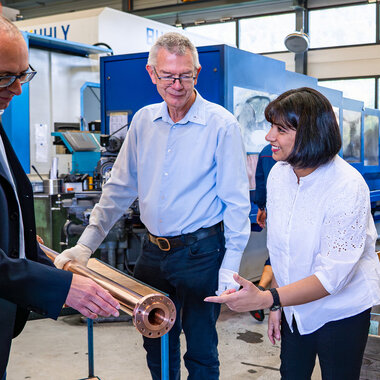 Hightech Zentrum Aargau (article in German)
Hightech Zentrum Aargau (article in German)
Self-Assembly of N-Rich Triimidazoles on Ag(111): Mixing the Pleasures and Pains of Epitaxy and Strain (11.2023)
In the present report, homochiral hydrogen-bonded assemblies of heavily N-doped (C9H6N6) heterocyclic triimidazole (TT) molecules on an Ag(111) substrate were investigated using scanning tunneling microscopy (STM) and low energy electron diffraction (LEED) techniques. The planar and prochiral TT molecules, which exhibit a threefold rotation symmetry and lack mirror symmetry when assembled on the substrate, carry multiple hydrogen-bonding donor and acceptor functionalities, inevitably leading to the formation of hexameric two-dimensionally extended assemblies that can be either homo- (RR/SS) or heterochiral (RS). Experimental STM data showing well-ordered homochiral domains and experimental LEED data are consistent with simulations assuming the R19.1° overlayer on the Ag(111) lattice. Importantly, we report the unexpected coincidence of spontaneous resolution with the condensation of neighboring islands in adjacent “Janus pairs”. The islands are connected by a characteristic fault zone, an observation that we discuss in the context of the fairly symmetric molecule and its propensity to compromise and benefit from interisland bonding at the expense of lattice mismatches and strain in the defect zone. We relate this to the close to triangular shape and the substantial but weak bonding scheme beyond van der Waals (vdW) of the TT molecules, which is due to the three N-containing five-membered imidazole rings. Density functional theory (DFT) calculations show clear energetic differences between homochiral and heterochiral pairwise interactions, clearly supporting the experimental results.
 A. Ahsan et al. Journal of Physical Chemistry C 127, 47 (2023)
A. Ahsan et al. Journal of Physical Chemistry C 127, 47 (2023)
Coordination-Driven Monolayer-to-Bilayer Transition in Two-Dimensional Metal–Organic Networks (14.3.2021)
We report on monolayer-to-bilayer transitions in 2D metal–organic networks (MONs) from amphiphiles supported at the water–air interface. Functionalized calix[4]arenes are assembled through the coordination of selected transition metal ions to yield monomolecular 2D crystalline layers. In the presence of Ni(II) ions, interfacial self-assembly and coordination yields stable monolayers. Cu(II) promotes 2D coordination of a monolayer which is then diffusively reorganizing, nucleates, and grows a progressive amount of second layer islands. Atomic force microscopic data of these layers after transfer onto solid substrates reveal crystalline packing geometries with submolecular resolution as they are varying in function of the building blocks and the kinetics of the assembly. We assign this monolayer-to-bilayer transition to a diffusive reorganization of the initial monolayers owing to chemical vacancies of the predominant coordination motif formed by Cu2+ ions. Our results introduce a new dimension into the controlled monolayer-to-multilayer architecturing of 2D metal–organic networks.
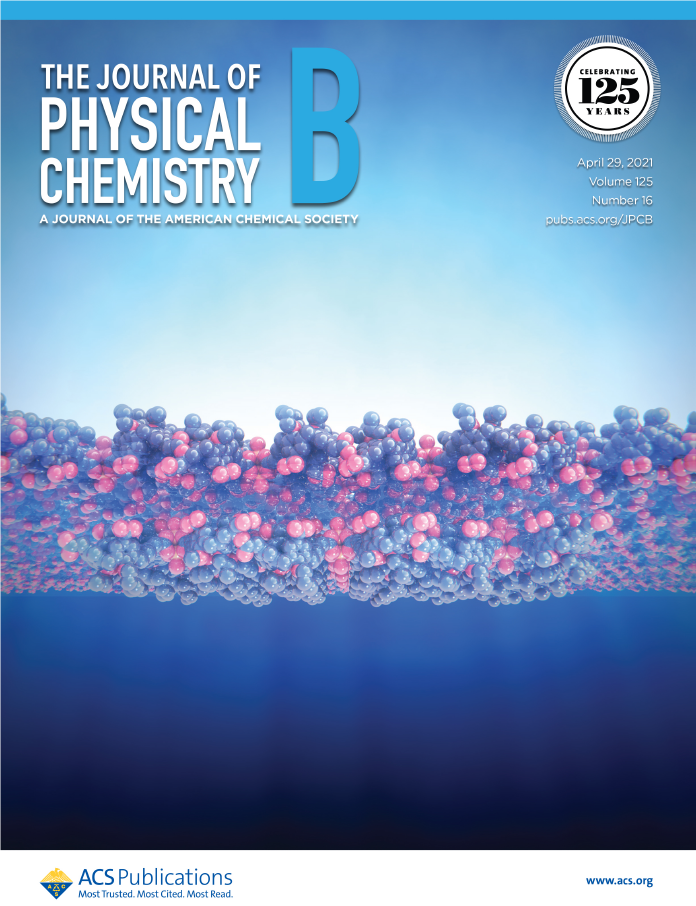 M. Moradi et al. J. Phys. Chem. B 2021, 125.
M. Moradi et al. Science Advances 5, eaav4489 (2019).
M. Moradi et al. J. Phys. Chem. B 2021, 125.
M. Moradi et al. Science Advances 5, eaav4489 (2019).
New class of substances for redox reactions (14.3.2021)
An interdisciplinary, multinational research team presents a new class of chemical compounds that can be reversibly oxidized and reduced. The compounds known as ‘pyrazinacenes’ are simple, stable compounds that consist of a series of connected nitrogen-containing carbon rings. They are suitable for applications in electrochemistry or synthesis, as the researchers describe in the science journal Communications Chemistry.
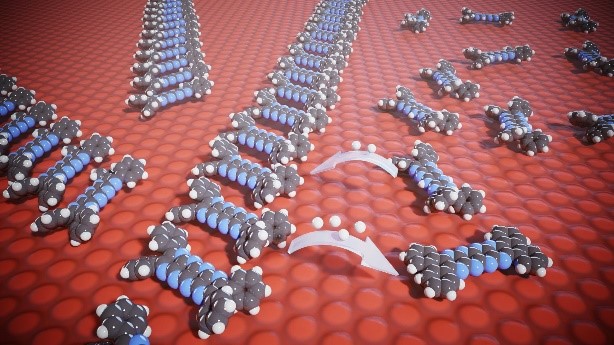 D. Miklik et al. Communication Chemistry 4, 29 (2021)
YouTube: New class of materials for redox reactions
D. Miklik et al. Communication Chemistry 4, 29 (2021)
YouTube: New class of materials for redox reactions
Silicon-as-a-semiconductor--silicon-carbide-would-be-much-more-efficient (05.09.2019)
High power SiC MOSFET technologies are critical for energy saving in, e.g., distribution of electrical power. They suffer, however, from low near-interface mobility, the origin of which has not yet been conclusively determined. Here, we present unique concerting evidence for the presence of interface defects in the form of carbon clusters at native thermally processed oxides of SiC. These clusters, with a diameter of 2–5 nm, are HF-etch resistant and possess a mixture of graphitic (sp2) and amorphous (sp3 mixed in sp2) carbon bonds different from the normal sp3 carbon present in 4H-SiC. The nucleation of such defects during thermal oxidation as well as their atomic structure is elucidated by state-of-the-art atomistic and electronic structure calculations. In addition, our property prediction techniques show the impact of the simulated carbon accumulates on the electronic structure at the interface.
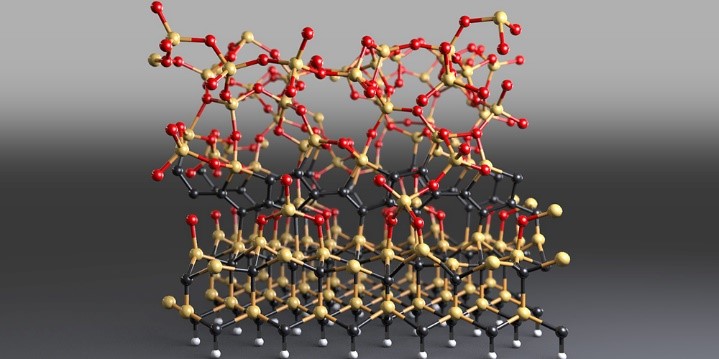 Appl. Phys. Lett. 115, 101601 (2019)
Appl. Phys. Lett. 115, 101601 (2019)
Phase Transitions in Confinements: Controlled Phase Transitions of Xe Atoms in an On-Surface Network (17.12.2018)
This study reports on “phase” transitions of Xe condensates in on-surface confinements induced by temperature changes and local probe excitation. The pores of a metal-organic network occupied with 1 up to 9 Xe atoms are investigated in their propensity to undergo “condensed solid” to “confined fluid” transitions. Different transition temperatures are identified, which depend on the number of Xe atoms in the condensate and relate to the stability of the Xe clustering in the condensed “phase.” This work reveals the feature-rich behavior of transitions of confined planar condensates, which provide a showcase toward future “phase-transition” storage media patterned by self-assembly. This work is also of fundamental interest as it paves the way to real space investigations of reversible solid to fluid transitions of magic cluster condensates in an array of extremely well-defined quantum confinements.
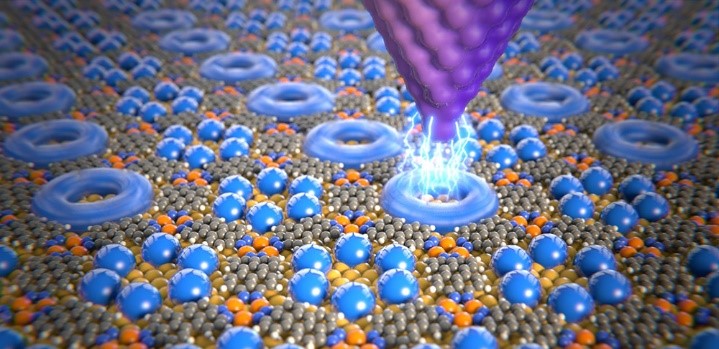 Appl. Phys. Lett. 115, 101601 (2019)
YouTube: Phase Transitions in Confinements
Appl. Phys. Lett. 115, 101601 (2019)
YouTube: Phase Transitions in Confinements
Imaging the Inside of Injection-Needles with Neutrons (28.5.2018)
Pre-filled syringes with staked-in needles are a popular option enabling patients to give themselves injections at home. These syringes are already filled with the liquid medication and commonly need to be kept cool. Depending on several conditions (the water vapour permeability of the needle's protective shield, the temperature history and the long-term storage condition), it is possible for the injection needle to become clogged. In order to better understand this phenomenon and minimise it in the long run, researchers from the Paul Scherrer Institute PSI, the University of Basel and the company F. Hoffmann-La Roche jointly sought to determine under which conditions the liquid medication inadvertently enters the injection needle. Their research results show that the storage conditions of the pre-filled syringes are truly crucial.
 j.ejpb.2018.02.016
j.ejpb.2018.05.006
PSI Media Releases
j.ejpb.2018.02.016
j.ejpb.2018.05.006
PSI Media Releases
Wafer-thin Magnetic Materials Developed for Future Quantum Technologies (22.5.2017)
Realization of long-range magnetic order in surface-supported two-dimensional systems has been challenging, mainly due to the competition between fundamental magnetic interactions as the short-range Kondo effect and spin-stabilizing magnetic exchange interactions. Spin-bearing molecules on conducting substrates represent a rich platform to investigate the interplay of these fundamental magnetic interactions. Here we demonstrate the direct observation of long-range ferrimagnetic order emerging in a two-dimensional supramolecular Kondo lattice. The lattice consists of paramagnetic hexadeca-fluorinated iron phthalocyanine (FeFPc) and manganese phthalocyanine (MnPc) molecules co-assembled into a checkerboard pattern on single-crystalline Au(111) substrates. Remarkably, the remanent magnetic moments are oriented in the out-of-plane direction with significant contribution from orbital moments. First-principles calculations reveal that the FeFPc-MnPc antiferromagnetic nearest-neighbour coupling is mediated by the Ruderman–Kittel–Kasuya–Yosida exchange interaction via the Au substrate electronic states. Our findings suggest the use of molecular frameworks to engineer novel low-dimensional magnetically ordered materials and their application in molecular quantum devices.
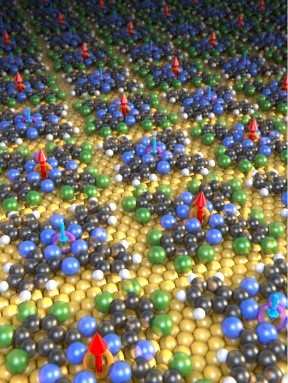 Nat.Comm.V8,15388 (2017)
PSI Media Releases
Nat.Comm.V8,15388 (2017)
PSI Media Releases
Controlling Quantum States Atom by Atom (9.6.2016)
A 2D array of electronically coupled quantum boxes is fabricated by means of on-surface self-assembly assuring ultimate precision of each box. The quantum states embedded in the boxes are configured by adsorbates, whose occupancy is controlled with atomic precision. The electronic interbox coupling can be maintained or significantly reduced by proper arrangement of empty and filled boxes.
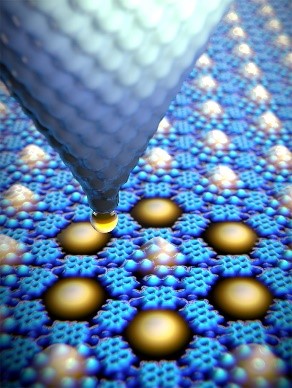 Small 12, 3757–3763 (2016)
Unibas Media Releases
Small 12, 3757–3763 (2016)
Unibas Media Releases
Physicists Measure van der Waals Forces of Individual Atoms for the First Time (13.5.2016)
Pre-filled syringes with staked-in needles are a popular option enabling patients to give themselves injections at home. These syringes are already filled with the liquid medication and commonly need to be kept cool. Depending on several conditions (the water vapour permeability of the needle's protective shield, the temperature history and the long-term storage condition), it is possible for the injection needle to become clogged. In order to better understand this phenomenon and minimise it in the long run, researchers from the Paul Scherrer Institute PSI, the University of Basel and the company F. Hoffmann-La Roche jointly sought to determine under which conditions the liquid medication inadvertently enters the injection needle. Their research results show that the storage conditions of the pre-filled syringes are truly crucial.
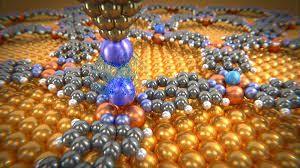 Nat. Comm. V7, 11559 (2016)
Unibas Media Releases
Nat. Comm. V7, 11559 (2016)
Unibas Media Releases
4,2':6',4''-terpyridine derivatives
Especially designed for experiments at the solid-vacuum interphase, 4,2':6',4''-terpyridines possess in contrast to the well-established chelating 2,2':6',2''-terpyridines only 2 coordination centers, resulting in a V-shaped building block allowing control over metal-organic assemblies.
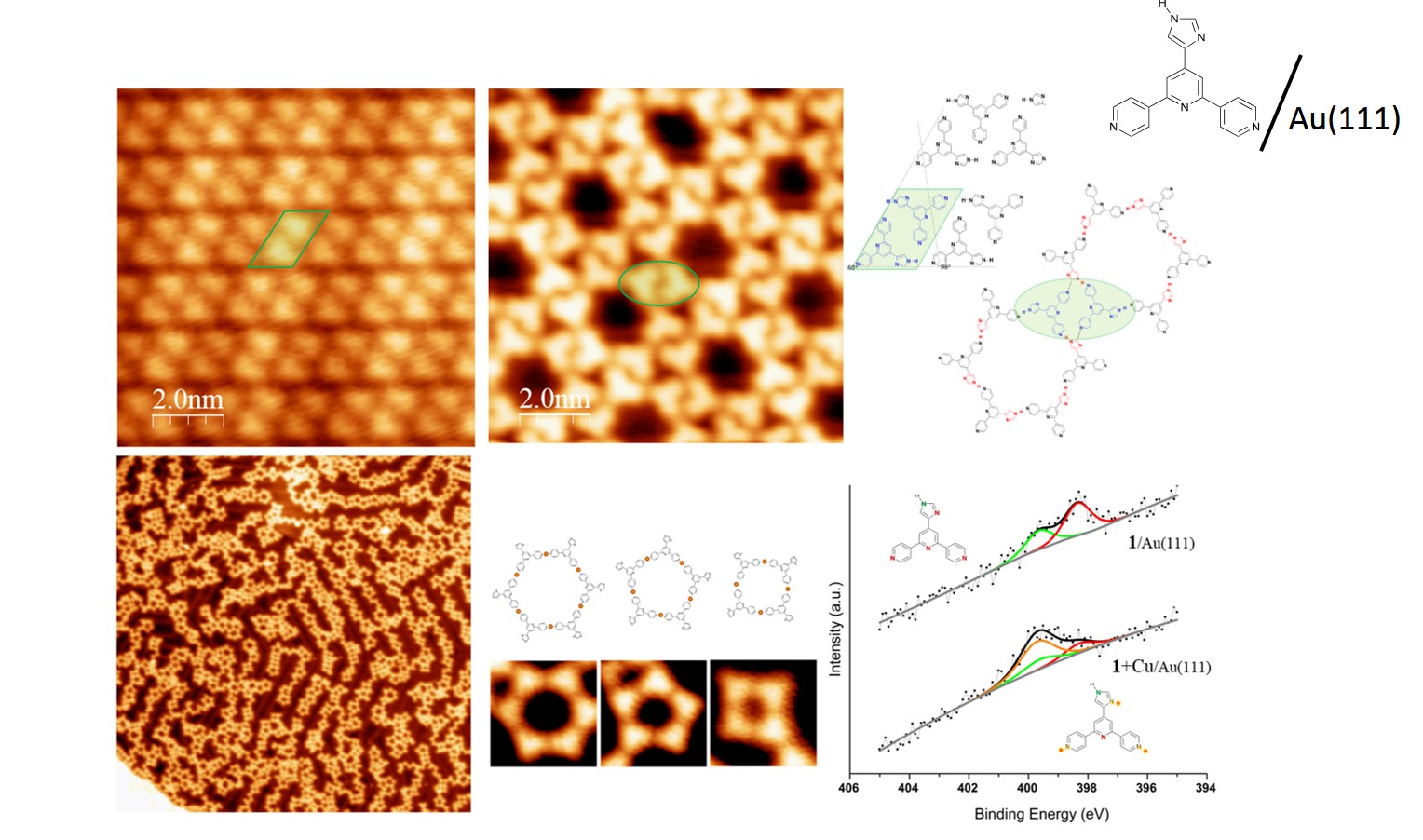
Interested in it's on-surface chemistry behavior, molecules have been deposited and depicted on the non-reactive Au(111) substrate. In a first attempt, we are seeking to build tunable confined reaction containers on top of a reactive metal catalyst. Therefore we investigate the interplay of the surface with the molecular backbone and it's functionalization in regard of different binding motives.
![]() Programmed assembly of 4,2':6',4''-terpyridine derivatives into porous, on-surface networks
Programmed assembly of 4,2':6',4''-terpyridine derivatives into porous, on-surface networks
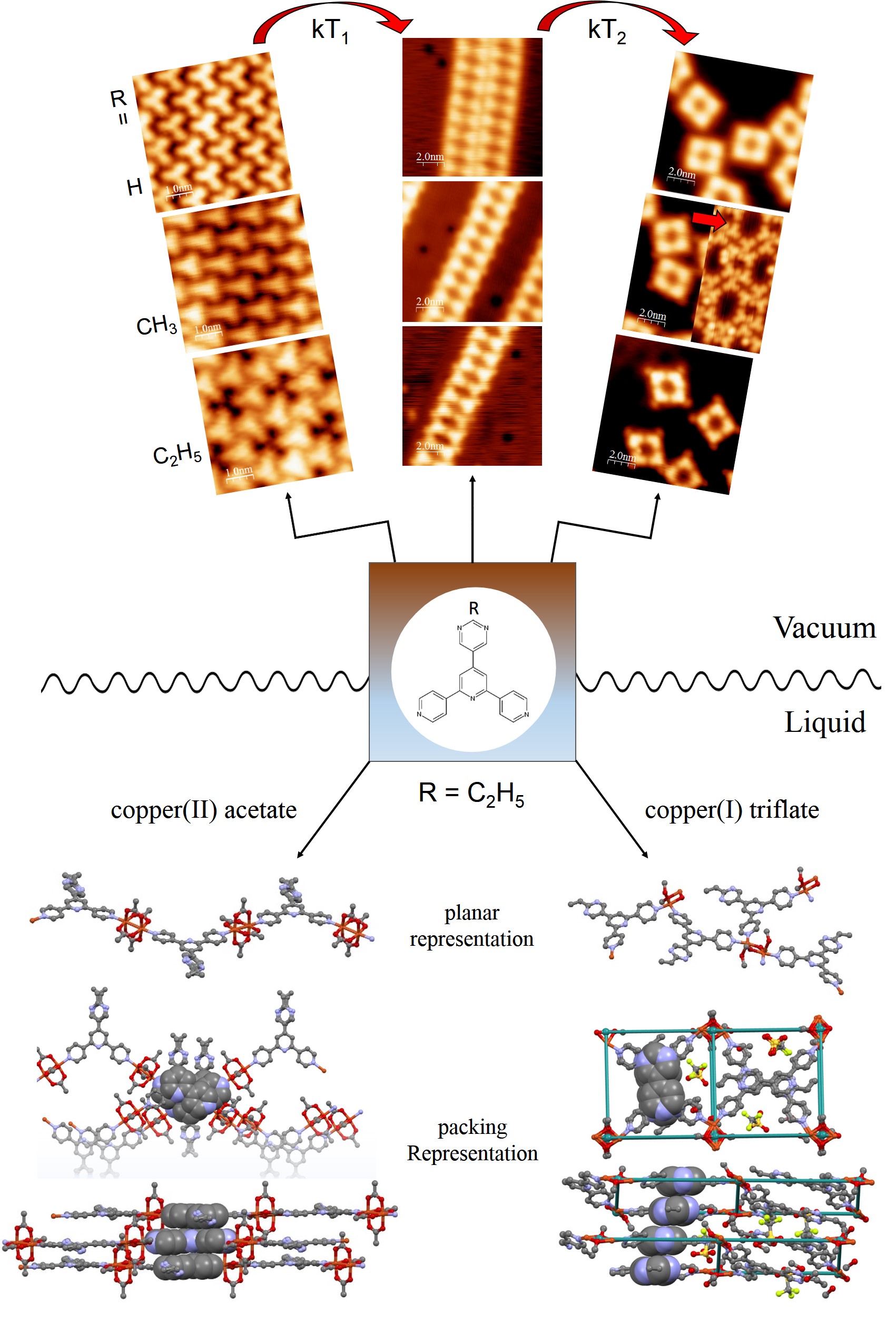
In a more in-depth study, we extend our research by a comparative study between 2D and 3D self-assemblies of the same molecule, on-surface and in-solution. In order to create a toolkit database regarding supramolecular conformation prediction, we examine guiding condensation and repelling forces of different functianlizations and investigate the role of the solvents and specific surface effects. Thereby the importance of even the smallest changes in the parameter space is demonstrated.
![]() The different faces of 4'-pyrimidinyl functionalized 4,2':6',4''-terpyridines: metal organic assemblies from solution and on Au(111) and Cu(111) surface platforms
The different faces of 4'-pyrimidinyl functionalized 4,2':6',4''-terpyridines: metal organic assemblies from solution and on Au(111) and Cu(111) surface platforms
